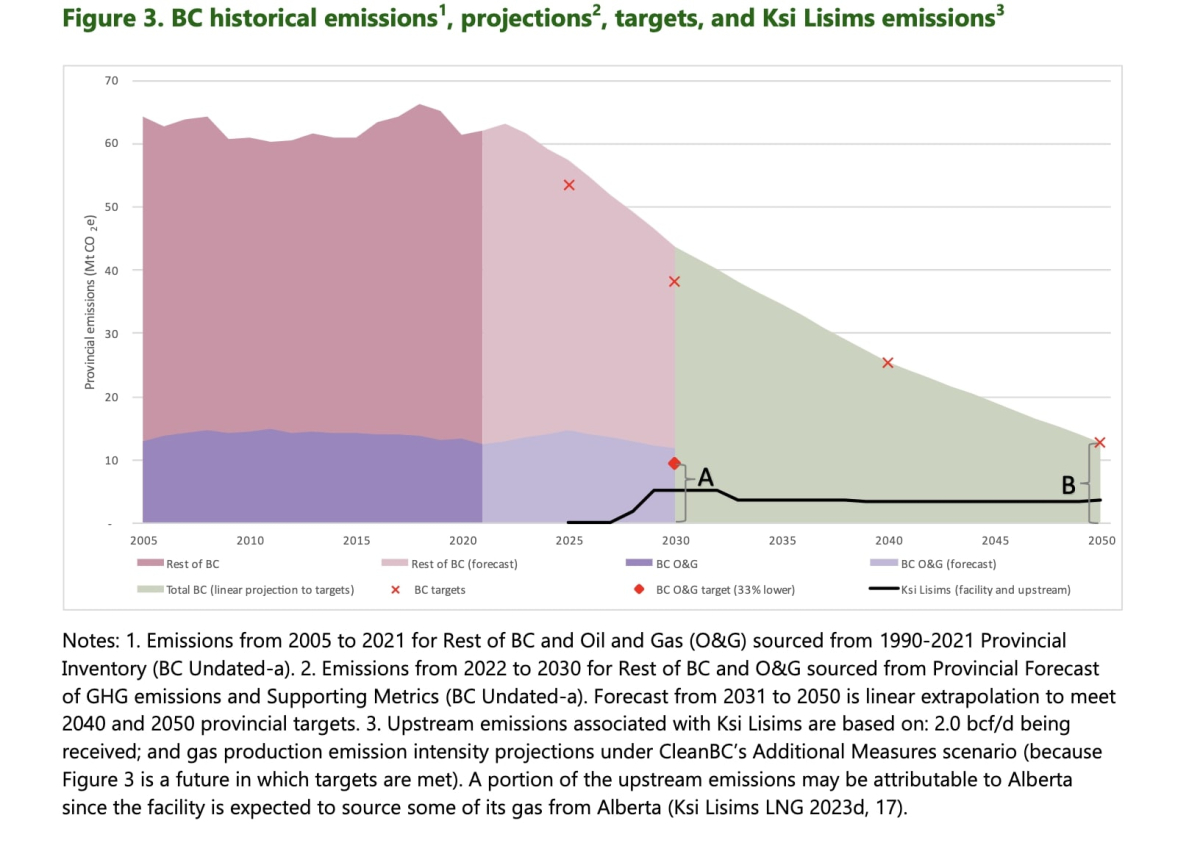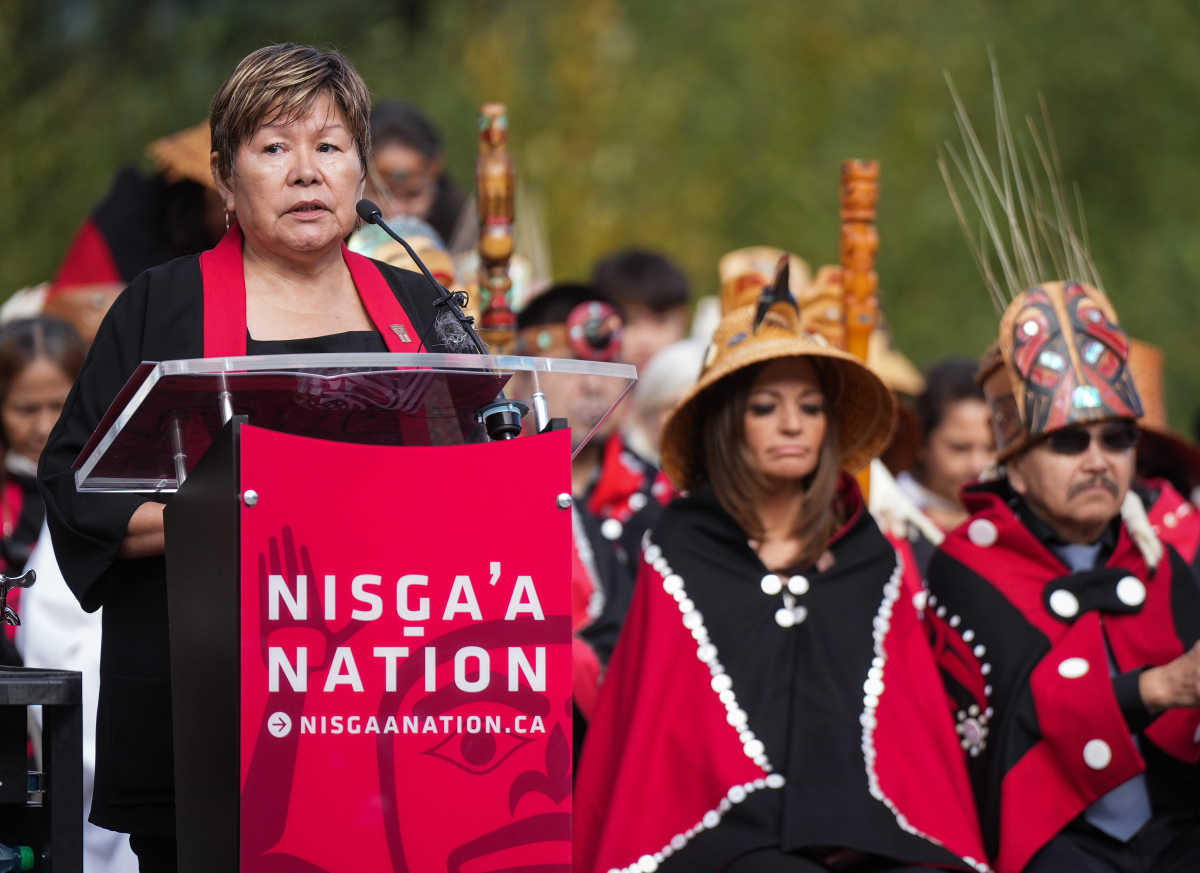Support strong Canadian climate journalism for 2025
A First Nation in northern British Columbia has released a report that pokes holes in climate claims about a proposed LNG project and adjacent pipeline led by the Nisga’a and their industry partners.
The report was commissioned by the hereditary chiefs of Gitanyow, a neighbouring nation. Titled, “Ksi Lisims LNG and Associated Development: Review of Climate Impacts,” it was written by Chris Joseph, an impact assessment specialist from Swift Creek Consulting.
The Gitanyow, who are locked in a legal land dispute with the Nisga’a, are critical of the Ksi Lisims LNG development. They are worried about overall climate concerns and regional impacts on Gitanyow salmon.
The report criticizes the narrow scope of the project’s environmental assessment, saying it underestimates climate impacts.
For the Nisga’a, however, the development promises prosperity and development now and for future generations. Canada’s National Observer reached out to Ksi Lisims LNG for comment and did not hear back by the time of publication.
However, in a press release on March 14, the Nisga’a announced the purchase of the Prince Rupert Gas Transmission pipeline (PRGT), which will carry gas to the Ksi Lisims floating facility from Hudson’s Hope.
The Nisga’a explained how important the project is for them. Eva Clayton, president of the Nisga'a Lisims Government overseeing the development with industry partners, said, “Today is a historic day for the Nisga’a Nation and represents a sea change in major industrial development in the country.”
The deal represents a new era for Indigenous participation in the Canadian economy, pointing to First Nations finally securing a source of generational wealth from the resources of their lands, Clayton added.
But the new Gitanyow report argues that: “Maintaining the narrow scope to just the Ksi Lisims facility is effectively project splitting and prevents decision-makers, [rights holders] and stakeholders from understanding the full extent of the climate impacts of the proposed development,” pointing to a split assessment of the pipeline and the LNG facility.
Ten years ago, First Nations in northern B.C. called for a regional assessment to set standards for the region facing an influx of proposed LNG development, said Tara Marsden, Wilp sustainability director for the Gitanyow hereditary chiefs.
The government did not pursue that course and “here we are 10 years later still reacting, still at the whim of these companies and their interests,” she said.
Instead, the B.C. government undertook environmental assessments and consultation on a project-by-project basis. For example, a decade ago, Gitanyow participated in an environmental assessment on the PRGT, which was initially going to direct gas to the now-defunct Pacific Northwest LNG. The pipeline was granted an environmental assessment certificate following submissions from area First Nations.
The new report maintains the 10-year-old environmental assessment is outdated because it will now service an entirely different project and the climate change context has changed.
A new assessment is now needed to account for the acceleration of climate change, drought and wildfires over the past decade, Marsden explained.
The B.C. government has already granted the pipeline the single extension allowed under the Environmental Assessment Act and its permits are set to expire in November — unless the project has been “substantially started,” which is decided on a case-to-case basis, a spokesperson for the Environmental Assessment Office (EAO) told Canada’s National Observer.
The EAO cannot comment on the project construction process and whether it can be completed by the deadline, the spokesperson added.
“The province needs to conduct another EA, since so much has changed in 10 years,” Sonia Furstenau, leader of the BC Green Party, said. As the report points out, the project is far larger than just the Ksi Lisims floating LNG facility. It includes a pipeline, new electricity transmission, shipping incremental gas and electricity production to power the plant, and distribution and combustion of the gas once it hits Asian markets.

Furstenau also recalls TC Energy’s bad record with Coastal GasLink and said B.C.’s processes for planning management and regulating pipeline construction are inadequate.
“We cannot bear to repeat the same mistakes,” she said.
At this point, Gitanyow remains locked out of the Ksi Lisims environmental assessments, with the provincial government saying there is no duty to consult Gitanyow on the LNG facility, Marsden said.
The EAO is reviewing Gitanyow’s concerns over the Ksi Lisims project and is currently working on a response to Gitanyow’s request, the spokesperson told Canada’s National Observer.
“Gitanyow Hereditary Chiefs will continue to have the opportunity to provide information that will be considered as part of the assessment process,” the statement from the EAO continued.
However, the government also recently told Gitanyow that no further genetic testing on fish that migrate to the Nass watershed would be done to measure the impacts on fisheries, a previous request of the First Nation, Marsden said.
Finally, the report also questions the reliance on carbon offsets and electrification.

Carbon offsets are investments, often in reforestation or conservation, that can lower a project’s carbon budget against cap-and-trade or carbon pricing.
The report questions the overemphasis on offsets, pointing to a competitive market created by several LNG facilities. More mitigation of the climate impacts on-site at the facility in both construction and operation is needed, according to the report. It’s unclear what carbon offsets will look like until the province updates its Forest Carbon Offset Protocol policy, which will be released in forthcoming weeks.
“The revenue from selling [carbon offsets] can be a valuable source of income for First Nations and other project owners and supports our efforts to further reduce or remove greenhouse gases,” a spokesperson for the Ministry of Environment and Climate Change Strategy told Canada’s National Observer.
Expanding the electricity grid also has additional environmental and economic impacts, with Marsden calling it a “head-scratcher,” given poor water levels and the unpopularity of new hydroelectric development in the province.
“There is this demand from a fossil fuel project that is undermining [ratepayers],” Marsden said, pointing to potential affordability concerns of electrified LNG development.
“We’re pretty confident in the findings and have shared it with both the proponent and the provincial government,” said Marsden.







Comments
I'm happy to hear that this project is being challenged, although it's unfortunate that it pits one First Nation against another. Yes, another BC Environmental Assessment needs to be done and I hope that it would look at all impacts related to Climate Change and the natural world. Also, there should have been federal environmental assessments of these LNG projects and pipelines, but the feds, under both the Conservatives and Liberals, have restricted the scope of what they assess (Impact Assessment now).
BC is already experiencing reduced hydro electric production capabilities due to Climate Change. How do we expect to have enough electricity to power all these LNG projects when they come on board?!
LNG was always a bad idea...
I think the Nisga'a are making a serious miscalculation when they talk about "future generations". Nobody is going to be shipping any liquefied natural gas anywhere in "future generations". EU use of natural gas is dropping every year, China is building massive solar and wind at an exponentially growing pace (they're not using all of it, but the Chinese government is not collectively stupid--they know their objective, they're moving on beefing up the grid as well, and if they have to make regulations forcing utilities to use the solar instead of the coal, they will do so). When China finishes their own renewable electric grid, they'll do just like what they did with railways--start building everyone else's so those companies have something to do. In ten years there will still be plenty of natural gas in use, but less, probably enough less that there will be far less need for anyone to liquefy it and ship it around. I really doubt this project will be making any money past 15 years at most. Future generations? Yeah right. Someone got sold a bill of goods by some unscrupulous white guys--again.